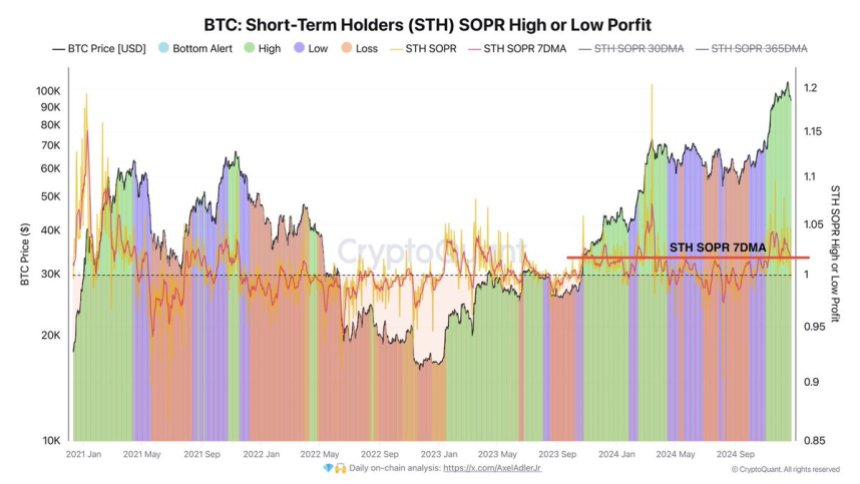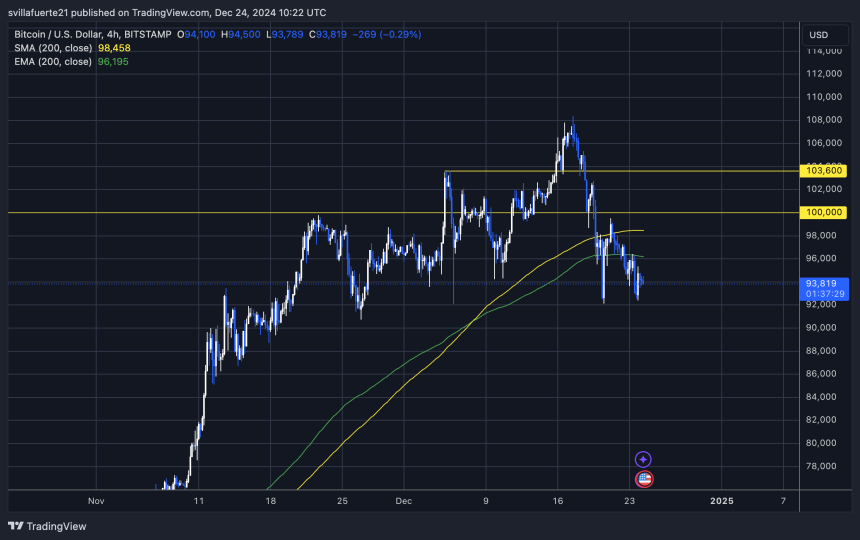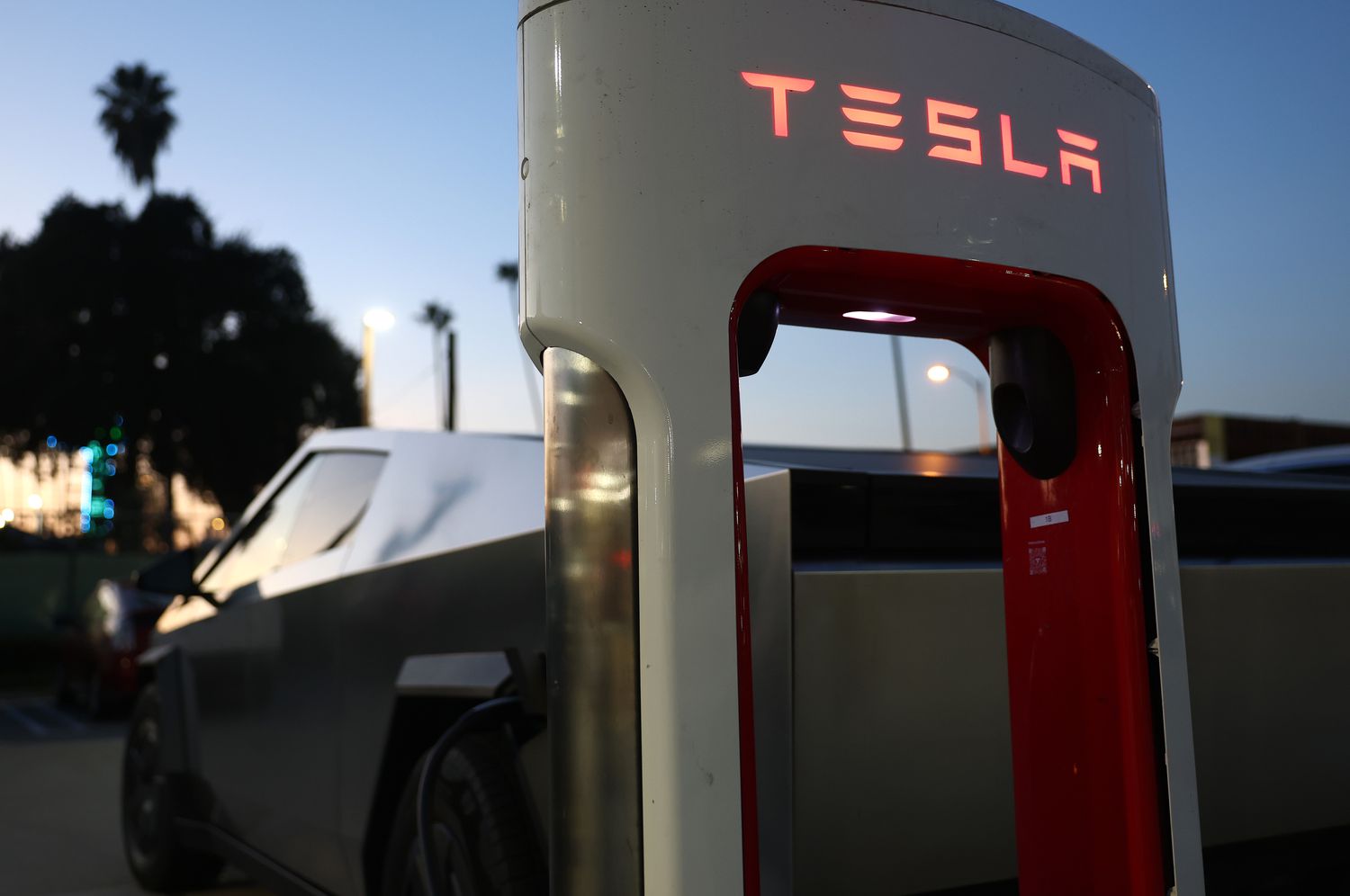Bitcoin Short-Term Holders Fueling Potential Dip – $90K Support Crucial Level To Hold

Bitcoin experienced a highly volatile trading session yesterday, with prices swinging between $92,300 and $96,420 throughout the day. The cryptocurrency now hovers near the $93,000 mark, struggling to establish a clear direction in the short term. As market participants await decisive action, uncertainty looms over whether Bitcoin will sustain its bullish structure or face a deeper correction.
CryptoQuant analyst Axel Adler recently shared valuable insights, highlighting a significant trend among short-term holders (STH). According to Adler, these investors continue to sell their coins at high-profit margins, capitalizing on Bitcoin’s recent upward momentum. While profit-taking is a natural part of market cycles, the lack of consistent demand to absorb this selling pressure could challenge Bitcoin’s price stability.
If demand fails to match the pace of active profit-taking, a local correction could occur, potentially leading to a decline in Bitcoin’s price. This delicate balance between profit-taking and market demand makes the coming days critical for determining Bitcoin’s next move. Will buyers step in to support the price, or will selling pressure lead to a deeper retrace? Investors and analysts are watching closely as Bitcoin navigates this pivotal moment.
Bitcoin Demand Levels Responding
Bitcoin has faced days of intense volatility as it struggles to break above the $100,000 psychological barrier while holding firm above the $92,000 support. The market remains in a state of flux, with investors and analysts closely monitoring Bitcoin’s next move. Despite the uncertainty, Bitcoin’s resilience at these key levels highlights the ongoing tug-of-war between bullish and bearish forces.
Top analyst Axel Adler recently shared an insightful analysis on X, shedding light on the behavior of short-term holders (STHs). According to Adler, STHs are actively selling their coins at high profit margins, taking advantage of the recent price surges. While profit-taking is a normal part of market cycles, a lack of consistent demand to counter this selling pressure could lead to a local correction and a potential price decline.

However, in the event of a price drop, STHs are unlikely to continue selling their holdings, as selling at a loss in a bull market is often considered an unwise move. This dynamic could provide Bitcoin with the breathing room needed to stabilize at its key support levels, currently around the $90,000 mark.
If Bitcoin successfully holds above $90,000, a period of consolidation around this level could create the foundation for the next rally, potentially propelling BTC to new all-time highs. The coming days will be critical in determining whether Bitcoin continues its ascent or faces a temporary setback.
BTC Holding Above $90K
Bitcoin is trading at $93,800 after enduring days of selling pressure and market uncertainty. Despite holding above key support at $92,000, the loss of both the 4-hour 200 moving average (MA) and exponential moving average (EMA) is a short-term bearish signal. These indicators, often viewed as gauges of market momentum, suggest that Bitcoin may need additional demand to regain upward traction.

For bulls to reclaim control and ignite a fresh rally, Bitcoin must recover these critical levels. The 4-hour 200 MA at $96,500 and the 4-hour 200 EMA at $98,500 are essential hurdles. Successfully pushing above these thresholds and securing a decisive close beyond them would confirm renewed bullish momentum.
If Bitcoin achieves this feat, the stage could be set for a massive rally into price discovery, breaking through psychological barriers like $100,000 and paving the way for new all-time highs. On the flip side, failing to reclaim these indicators might signal extended consolidation or a potential retest of lower support levels.
Featured image from Dall-E, chart from TradingView
Read More

Why Does This Bitcoin Cycle Feel So Boring? Analyst Weighs In
Are Teslas reliable?
Your guide: Are Teslas reliable?
With its cutting-edge electric cars, Tesla has changed the way cars are made. As long as the company controls the EV market, many people who want to buy one are curious about how reliable these high-tech machines are. So, Are Teslas reliable? Today, we’ll cover just that. Keep reading to find out more.
Also read: Tesla (TSLA) Keeps Breaking Records: Why Trump Will Bring Even More Gains

Tesla’s journey in the car business has been nothing short of amazing. The company has been through a lot, from being a small start-up to becoming a well-known brand. When we look into how reliable Tesla cars are, we’ll look at a number of factors, such as consumer reports, expert opinions, and Tesla owners’ real-life experiences.
Are Teslas reliable?
Understanding Reliability Metrics
Before you judge the dependability of any car, even a Tesla, you need to know how this metric is calculated. Many organizations and resources can help you figure out how reliable a car is. Some of these are RepairPal, Consumer Reports, and J.D. Power.
These groups look at things like how often repairs need to be done, how much they cost, and how satisfied customers are overall. The National Highway Traffic Safety Administration (NHTSA) and the Insurance Institute for Highway Safety (IIHS) also give safety ratings that they look at.
Tesla’s Reliability Rankings
Consumer Reports, a reliable source for fair product testing and research focused on consumers, has given us some interesting information about how reliable Tesla is. Tesla has had some problems in this area in the last few years. Ratings of how reliable the brand is have always been below average.
It’s important to keep in mind, though, that not all Tesla models are as reliable as others. As with most things, some models have totally gotten better over time:
Model-Specific Reliability
The Model S, the Model 3, the Model X, and the Model Y are Tesla’s four main models at the moment. Any of these cars could break down at any time, but some are more reliable than others. Let’s look closely at how well each model works.
Tesla Model 3 is an absolute Reliability Star
The Model 3, which is Tesla’s least expensive car, has a lot of good points. Consumer Reports gave the Model 3 an average score for how reliable they thought it would be. That is big news for a brand of cars that is still pretty new.

The Tesla Model Y: Improving with Time
Tesla’s small SUV, the Model Y, has become more reliable since it first came out. The first models had some problems, but new updates and improvements have made them more reliable. But in terms of dependability, it’s still not as good as the Model 3.
Tesla Model S: A Mixed Bag
The Model S, Tesla’s most expensive sedan, has had a lot of problems with reliability. A few years ago, it got good grades, but now people aren’t so sure about how reliable it is. Lots of owners have said that the electronics and air suspension in their cars aren’t working right.
The Tesla Model X
People have always said that the Model X is the least reliable Tesla model. This is the one with cool wing doors that open upwards. People who own the car have said that they are having trouble with the complicated door mechanism and the electronics and climate system.
Common Reliability Issues
Even though Tesla cars are known for having cool features and performing well, they do have some reliability problems. Some problems that Tesla owners often report are the following:
Problems with electronics
- Set up quality problems.
- Problems with the paint and body panels
- Concerns about battery degradation
- Autopilot and self-driving features don’t work.
It’s important to note that Tesla has taken the initiative to fix many of these problems by providing over-the-air software updates and constantly improving the way they make their cars.

Tesla’s Method for Making Things Reliable
When it comes to dependability, Tesla is the only company that does things the way they do them. Since the business focuses on software-based solutions, they can quickly fix and make changes to their whole fleet. When it comes to cars, Tesla is unique because it can update its cars from afar.
Also read: Tesla: This Positive Development Could Help TSLA Soar Beyond $500
Let’s talk about Battery Technology
One of the most important parts of any electric car is the battery. There are a lot of reasons why Tesla cars are so reliable: their batteries are some of the best in the world. Many Tesla owners feel safe knowing that their batteries are covered for 8 years or 100,000 miles.
However, owners and potential buyers are still talking about their worries about how the batteries will last and how much they will cost to replace in the future. As Tesla keeps making its battery technology better, these issues might be fixed in later models.

Conclusion: Are Teslas Reliable?
All in all, most signs point to yes. Most folks who have a Tesla typically love it. That being said, of course there are going to be issues. With a little bit of research and checking out some community boards you’ll see what consumers are saying. Good luck car hunting out there!


